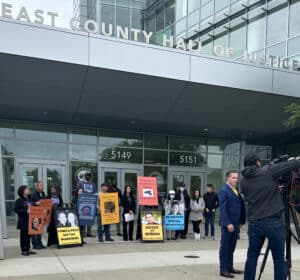Written By Chris Dolan and Nancy Villatoro
This week’s question comes from Calvin from Hayward, CA, who asks: News reports have talked about defective eye drops, and they mentioned that the FDA had recalled many eye drop brands. Can you discuss why this is happening and what people can do if they are injured by them?
The Centers for Disease Control and Prevention (CDC), the Food and Drug Administration (FDA), and state and local health departments are investigating a multistate outbreak of an extensively drug-resistant strain of Pseudomonas aeruginosa. According to the CDC, this bacterial outbreak has been associated with multiple eye infections nationwide. So far, this bacterial outbreak has affected 68 patients in 16 states, including patients in California. Thus far, the most severe cases include three deaths, eight people experiencing vision loss, and four undergoing enucleation, surgical eyeball removal.
Most patients affected by this bacterium have reported using artificial tears, more commonly known as eye drops. The FDA has issued a recall on three eye drop brands. The FDA and the CDC recommend that people stop using the products they have recalled. Some side effects to be vigilant for include:
- Yellow, green, or clear discharge from the eye
- Eye pain or discomfort
- Redness of the eye or eyelid
- Feeling of something in your eye (foreign body sensation
- Increased sensitivity to light
- Blurry vision
Use the following websites to determine if your product has been recalled: FDA.gov, CPSC.gov, Recalls.gov, NHTSA.gov, FSIS.USDA.gov, and Foodsafety.gov. If you believe you have purchased and used an unsafe or mislabeled product, you may report the product to FoodSafety.gov.
If you or a loved one have sustained an injury due to eye drops, you may be entitled to compensation under a claim of products liability. However, thoroughly understanding the legal components and requirements involving a defective product and presenting a solid case is crucial.
To build a solid products liability claim, you must ultimately do the following:
- Show the product was defective.
- Prove liability.
- Prove that the defective or dangerous product resulted in your personal injury.
Types of Product Defects
Products liability claims generally fall into three categories:
- Design Defect. A design defect claim argues that a product’s design is inherently dangerous or defective. This claim does not suggest that an error occurred during the manufacturing process of a product but that an entire line of products is dangerous or bound to be defective, as all products in a certain line utilize the same design. Some design defect examples include a vehicle tire that blows out at certain speeds or a clothes dryer that becomes too hot and starts a fire. In California, two tests are used to determine liability: the risk/benefit test, and the consumer expectations test.
- Manufacturing Defect. A manufacturing defect claim arises when a product becomes flawed due to an error in manufacturing, which is then unlike the standard, other items of the product line, and subsequently causes injury. Therefore, although the product line’s design is safe, the manufacturing of a particular product varied from the specifications, resulting in a malfunction. An example is when a seatbelt is accidentally left out of a vehicle during manufacturing or a product becomes contaminated while it is being sealed.
- Lack of Adequate Warnings or Instructions. This claim results from a product failing to provide enough instructions regarding proper usage or warnings. An example is when a medication lacks warnings about specific drug interactions or lists possible side effects.
Proving Liability
To prove liability in a defective product claim, you need to prove that the product was being used as intended, the product was defective, you were injured or suffered harm, and that harm was caused due to the defect. For this, evidence is key.
Evidence includes the defective product, photos and videos documenting the injuries, the defect, or even the incident, medical bills, accident reports, witness statements, insurance documents, emails, marketing materials, or memos showing the manufacturer knew of the defect.
Possible Defenses
In California, a manufacturer may have defenses to defend against fault. First, the product was misused or modified in a way that was not reasonably foreseeable, and that misuse or modification was the sole cause of the injuries. Second, the user is a “sophisticated user,” meaning that because of experience, knowledge, or skill, the user knew or should have known that the product was dangerous.
Damages
The compensation you may receive in a product liability case varies depending on the misconduct’s type, severity, and ramifications. Specifically, in claims involving products, generally, the damages have to be primarily due to the costs of the litigation. Furthermore, it is important that if you are the victim of a defective, unsafe, or dangerous product, you keep the product to prove it was the one that caused your loss.










